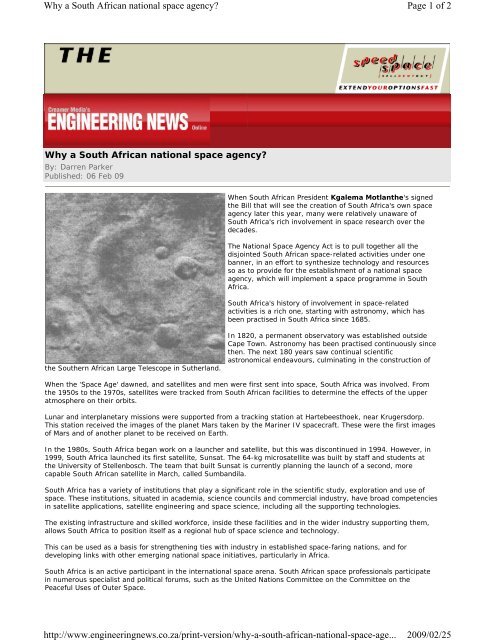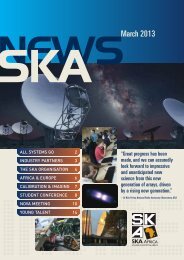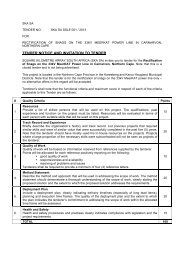Page 1 of 2 Why a South African national space agency ... - SKA
Page 1 of 2 Why a South African national space agency ... - SKA
Page 1 of 2 Why a South African national space agency ... - SKA
You also want an ePaper? Increase the reach of your titles
YUMPU automatically turns print PDFs into web optimized ePapers that Google loves.
<strong>Why</strong> a <strong>South</strong> <strong>African</strong> <strong>national</strong> <strong>space</strong> <strong>agency</strong><br />
http://www.engineeringnews.co.za/print-version/why-a-south-african-<strong>national</strong>-<strong>space</strong>-age...<br />
<strong>Page</strong> 1 <strong>of</strong> 2<br />
2009/02/25<br />
<strong>Why</strong> a <strong>South</strong> <strong>African</strong> <strong>national</strong> <strong>space</strong> <strong>agency</strong><br />
By: Darren Parker<br />
Published: 06 Feb 09<br />
When <strong>South</strong> <strong>African</strong> President Kgalema Motlanthe's signed<br />
the Bill that will see the creation <strong>of</strong> <strong>South</strong> Africa's own <strong>space</strong><br />
<strong>agency</strong> later this year, many were relatively unaware <strong>of</strong><br />
<strong>South</strong> Africa's rich involvement in <strong>space</strong> research over the<br />
decades.<br />
The National Space Agency Act is to pull together all the<br />
disjointed <strong>South</strong> <strong>African</strong> <strong>space</strong>-related activities under one<br />
banner, in an effort to synthesize technology and resources<br />
so as to provide for the establishment <strong>of</strong> a <strong>national</strong> <strong>space</strong><br />
<strong>agency</strong>, which will implement a <strong>space</strong> programme in <strong>South</strong><br />
Africa.<br />
<strong>South</strong> Africa's history <strong>of</strong> involvement in <strong>space</strong>-related<br />
activities is a rich one, starting with astronomy, which has<br />
been practised in <strong>South</strong> Africa since 1685.<br />
the <strong>South</strong>ern <strong>African</strong> Large Telescope in Sutherland.<br />
In 1820, a permanent observatory was established outside<br />
Cape Town. Astronomy has been practised continuously since<br />
then. The next 180 years saw continual scientific<br />
astronomical endeavours, culminating in the construction <strong>of</strong><br />
When the ‘Space Age' dawned, and satellites and men were first sent into <strong>space</strong>, <strong>South</strong> Africa was involved. From<br />
the 1950s to the 1970s, satellites were tracked from <strong>South</strong> <strong>African</strong> facilities to determine the effects <strong>of</strong> the upper<br />
atmosphere on their orbits.<br />
Lunar and interplanetary missions were supported from a tracking station at Hartebeesthoek, near Krugersdorp.<br />
This station received the images <strong>of</strong> the planet Mars taken by the Mariner IV <strong>space</strong>craft. These were the first images<br />
<strong>of</strong> Mars and <strong>of</strong> another planet to be received on Earth.<br />
In the 1980s, <strong>South</strong> Africa began work on a launcher and satellite, but this was discontinued in 1994. However, in<br />
1999, <strong>South</strong> Africa launched its first satellite, Sunsat. The 64-kg microsatellite was built by staff and students at<br />
the University <strong>of</strong> Stellenbosch. The team that built Sunsat is currently planning the launch <strong>of</strong> a second, more<br />
capable <strong>South</strong> <strong>African</strong> satellite in March, called Sumbandila.<br />
<strong>South</strong> Africa has a variety <strong>of</strong> institutions that play a significant role in the scientific study, exploration and use <strong>of</strong><br />
<strong>space</strong>. These institutions, situated in academia, science councils and commercial industry, have broad competencies<br />
in satellite applications, satellite engineering and <strong>space</strong> science, including all the supporting technologies.<br />
The existing infrastructure and skilled workforce, inside these facilities and in the wider industry supporting them,<br />
allows <strong>South</strong> Africa to position itself as a regional hub <strong>of</strong> <strong>space</strong> science and technology.<br />
This can be used as a basis for strengthening ties with industry in established <strong>space</strong>-faring nations, and for<br />
developing links with other emerging <strong>national</strong> <strong>space</strong> initiatives, particularly in Africa.<br />
<strong>South</strong> Africa is an active participant in the inter<strong>national</strong> <strong>space</strong> arena. <strong>South</strong> <strong>African</strong> <strong>space</strong> pr<strong>of</strong>essionals participate<br />
in numerous specialist and political forums, such as the United Nations Committee on the Committee on the<br />
Peaceful Uses <strong>of</strong> Outer Space.
<strong>Why</strong> a <strong>South</strong> <strong>African</strong> <strong>national</strong> <strong>space</strong> <strong>agency</strong><br />
http://www.engineeringnews.co.za/print-version/why-a-south-african-<strong>national</strong>-<strong>space</strong>-age...<br />
<strong>Page</strong> 2 <strong>of</strong> 2<br />
2009/02/25<br />
Currently, <strong>South</strong> Africa and Australia are vying for the opportunity to host the Square Kilometre Array (<strong>SKA</strong>), the<br />
largest and most sensitive radio telescope ever to be established.<br />
The <strong>SKA</strong> will consist <strong>of</strong> thousands <strong>of</strong> dishes between 10 m and 15 m in diameter. Special antenna tiles in the core<br />
<strong>of</strong> the array will form a ‘radio fish-eye lens' for all sky monitoring at low frequencies. This will allow many<br />
independent observations to be performed simultaneously.<br />
A final decision regarding its location is to be given in 2010, while the construction is to begin in 2014. If built in<br />
<strong>South</strong> Africa, the core <strong>of</strong> the <strong>SKA</strong> will be in the Karoo region <strong>of</strong> the Northern Cape Province.<br />
Outer stations will fan out from the core in a spiral pattern, with proposed remote stations in several other <strong>African</strong><br />
countries and neighbouring islands.<br />
Copyright Creamer Media (Pty) Ltd. All rights<br />
reserved.<br />
Tel: +27(0)11 622 3744 | Fax +27(0)11 622 9350 |<br />
newsdesk@engineeringnews.co.za<br />
http://www.engineeringnews.co.za








